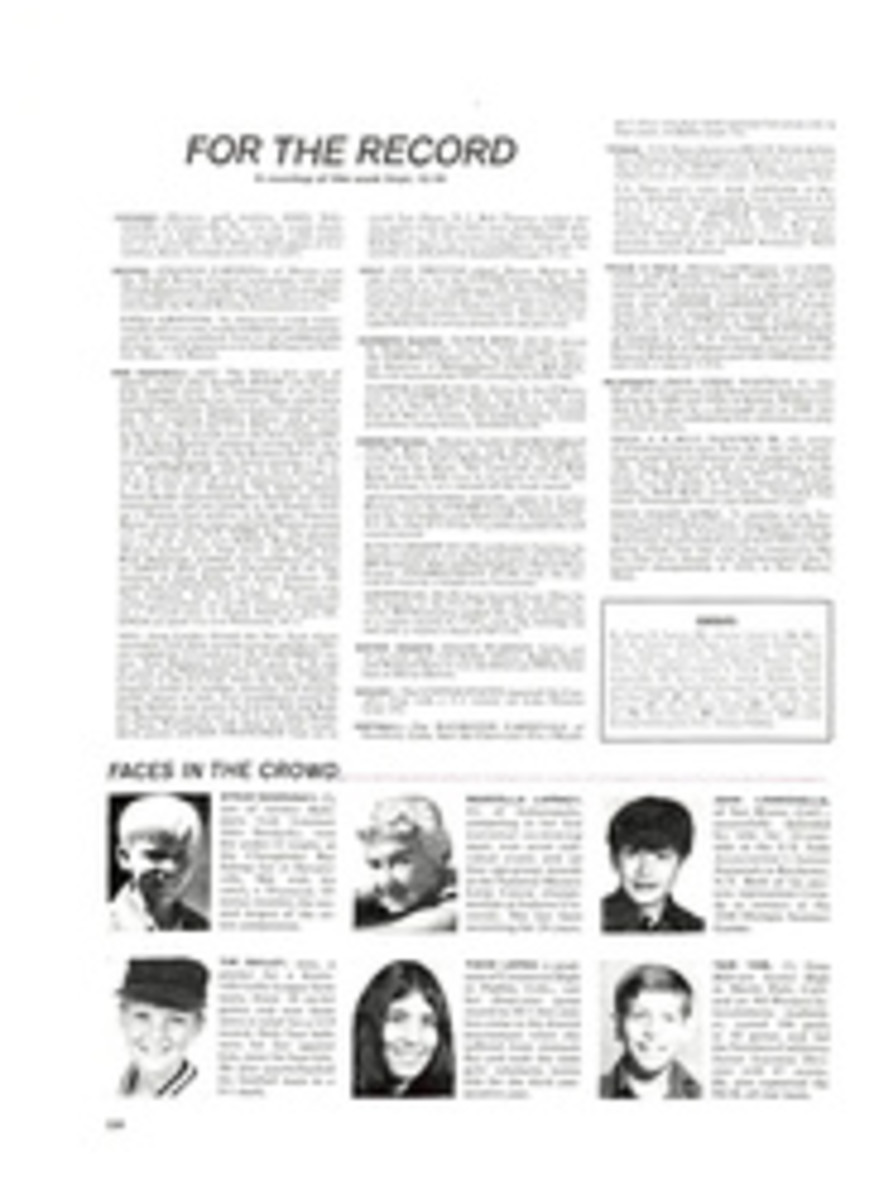
IT HAS A LOT MORE UPS THAN DOWNS
A dog barks down below and a redheaded woodpecker is tapping on a tree. Butterflies are adrift against the lavender blossoms of a vast alfalfa field, and a Baltimore oriole flashes orange upon the deep green of a maple grove. There is a boxy white farmhouse, and one can hear quite clearly the squeak of a rocking chair and the desultory murmur of a summer noontime conversation between two women sitting on the broad front porch.
The Iowa world lies down there, Lilliputian farms and cornfields and a herd of cows the size of a handful of peanuts. It is clearly seen and plainly heard by men standing at peace in the sky, dangling in a tiny wicker basket suspended beneath a balloon full of heated air.
Ballooning is something of a sweet anachronism in this desperate and hurried age, a remarkably delicate, gentle, civilized amusement practiced by persons of good taste and romantic sensibilities. There are only about 250 active balloonists in the U.S. today, not more than 100 hot-air balloons for them to fly. It is a private sport and though balloonists may wax enthusiastic over its future growth and potential popularity, they still are firmly against any vast proliferation of balloons. Don Piccard, best-known manufacturer of the fine old traditional wicker-basket style of bag, says, "I don't really like to make a balloon for a man I don't know. But the sport is growing and one of these days—soon, I am afraid—there will be someone mass-producing them. Dammit."
Perhaps it will come to that; the appeal of the balloon is profound. The 1972 National Hot-Air Balloon Championships were held last summer in the hamlet of Indianola, Iowa, and there were more American balloonists (47) assembled there than had ever been together before. Steve Langjahr, a California biology professor who was balloon-meister for the occasion, said, "Balloons are something from the past. They haven't changed very much since Montgolfier's balloons went up in Paris in the 18th century. About the only thing different now is that some people prefer an aluminum basket to the wicker. Also we have nylon bags, and there are on-board heaters to keep us aloft. But the real appeal is that balloons come from another time when life was quieter, simpler, maybe fuller. We cherish the traditions of ballooning."
At Indianola, in keeping with one of those traditions, each competitor was issued three bottles of champagne as soon as he arrived. "You should never go up without a bottle of good wine aboard," said Norton Grim, a pre-med student from California who was assistant balloon-meister. "We never know where we will land, and it has always been the practice of devoted balloonists to share a glass of champagne with the first person to arrive at his balloon after it comes down. Originally this was to smooth over any hostility landowners might feel at seeing a bag of hot air come down on their property, but I haven't run into a hostile farmer yet—balloons seem to make people feel good."
This was not always the case. In the days of the randy, barn-storming balloonists, around the turn of this century, most farmers did not smile at all. They hid their daughters when word was out that balloonists were around. "Yes, the old smoke balloonists were considered a danger to the local fair sex," says Captain Eddie Allen, a grizzled septuagenarian and former smoke balloonist who has made more than 3,250 flights since his first ascension in 1913. His great-uncle went up more than 100 years ago with famed hot-air genius Thaddeus Lowe, the man who designed the observation balloons used by the Union against the Confederacy in the Civil War. "In my heyday," recalls Captain Eddie, "I used to scare the pants off people by hanging with one hand from my basket and eating an ice-cream cone. People didn't quite know what to make of us—we were like men from the moon. I know that back then there wasn't a hotelkeeper in the country who would put sheets on a bed in a room where a known balloonist was going to sleep: they were all convinced we'd steal 'em to patch our balloons."
Nowadays bed sheets would not do. A hot-air balloon is made of shiny nylon, and the 70-foot bag is inflated with heated air from propane-fueled burners. Once aloft, a balloon can be controlled—induced to go up or down—through continued blasts of heat, a shot of flame from the on-board burner a couple of times every minute. It is slow and clumsy work, though, and a man must keep a sharp eye out for water tanks, steeples, weather vanes and, most lethal of all, power lines. There is absolutely no steering of balloons in any direction but that in which the wind doth blow. David Little, a partner in a Statesville, N.C. teaching-and-exhibitions company called Balloon Ascensions Ltd., says, "It's the one thing about ballooning that all of us really love most. I guess it's the antithesis of the American Dream, because it's so sort of useless, but I've seen a raccoon in a tree and a skunk running in a field and I've flown above a hawk. I've listened to crickets chirping 'way down there. I've picked the leaves off the top of a 100-foot oak tree. I've never known where I was going or when I would come down, and when I was in my balloon I didn't give a damn. Not one damn, because I was free, which is something people who stay on the ground can't really say or maybe even understand."
Balloonists seem to expend a fair amount of effort trying to find the best possible way to convey the sense of liberty and buoyancy they experience when they're aloft. Perhaps when all the hand signals and the searching for poetic adjectives are done, a bearded and erratic-haired Lockheed engineer named Deke Sonnichsen has found the most thoroughly satisfying answer to the problem. When he is aloft, Sonnichsen simply shouts into the sky a poem written by William Blake called "Eternity":
He who binds to himself a Joy
Does the winged life destroy;
But he who kisses the Joy as it flies
Lives in Eternity's sunrise.

